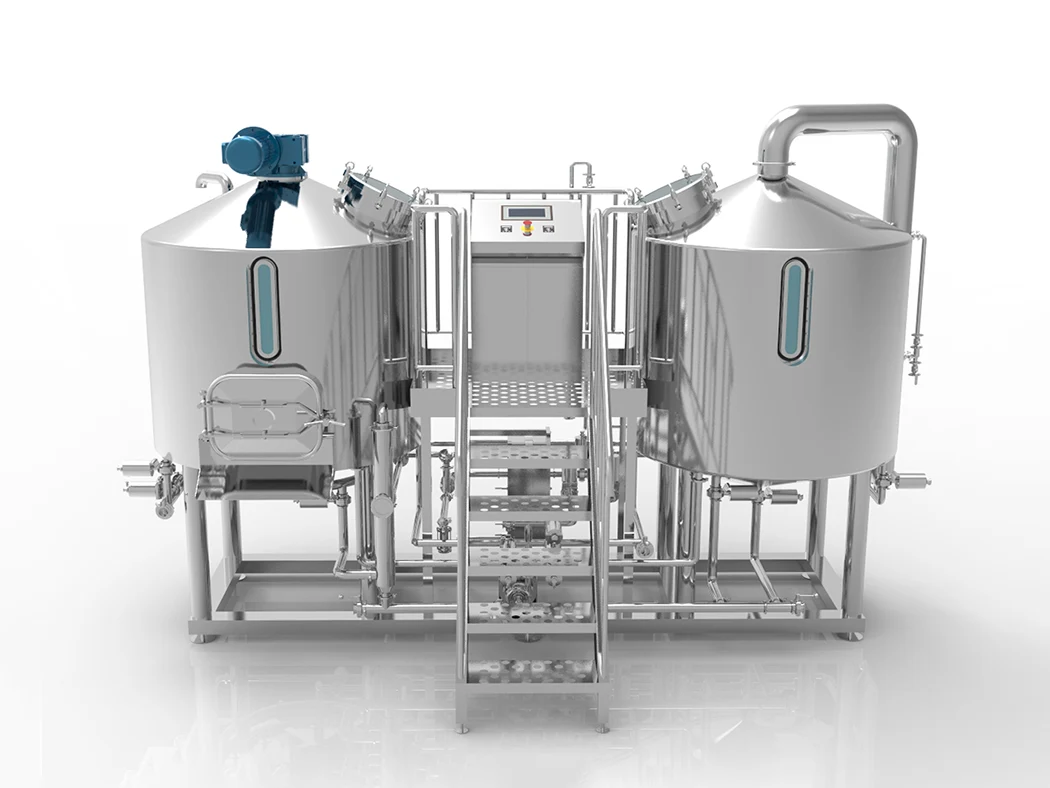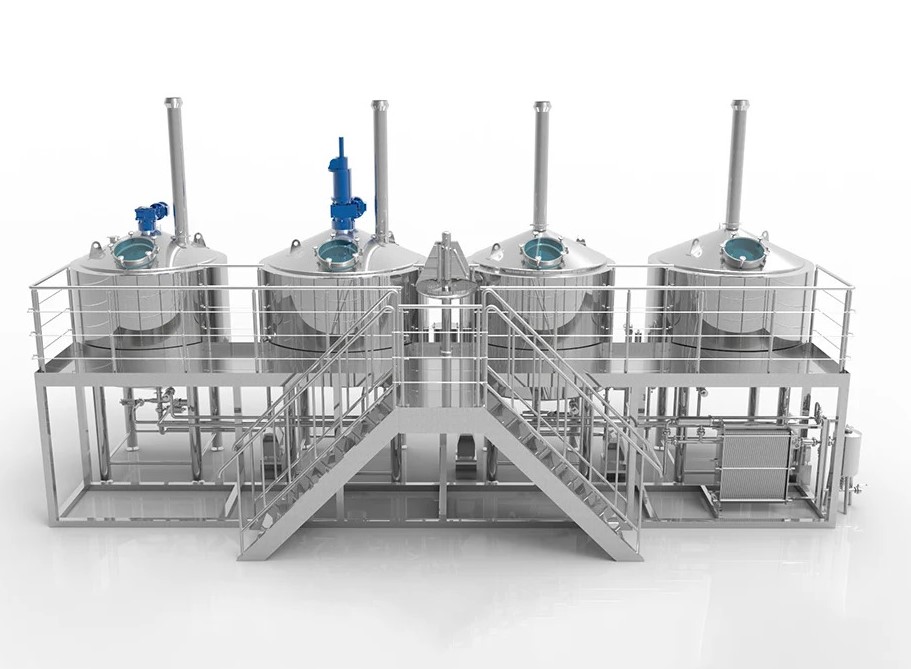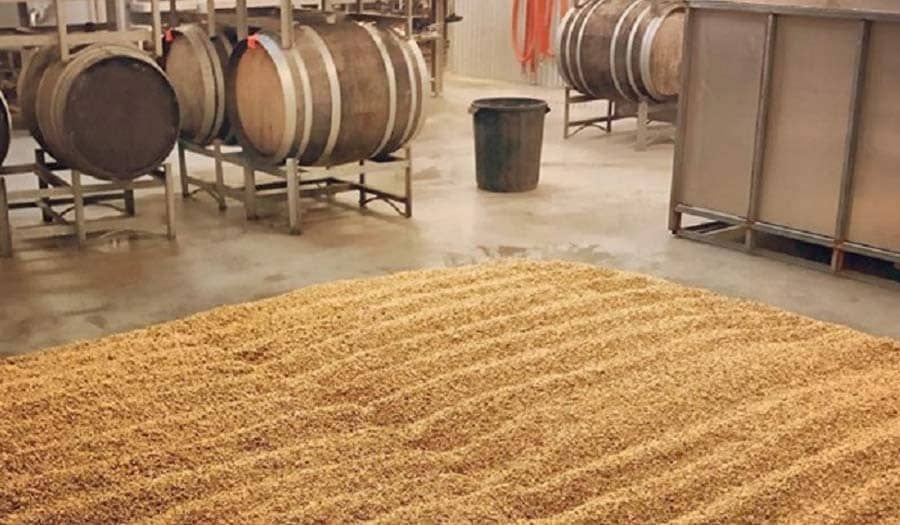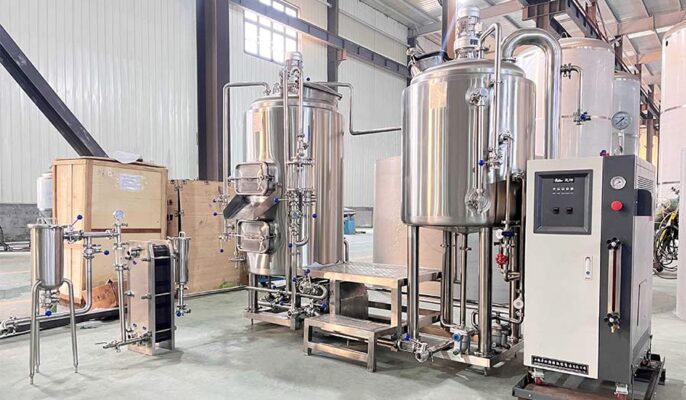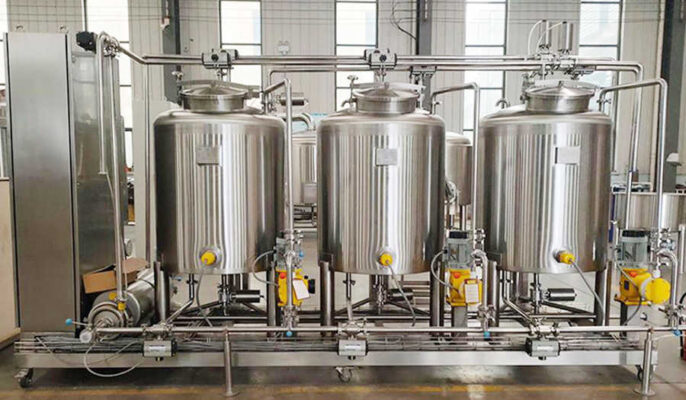A produção caseira de cerveja é um passatempo popular que produz cervejas artesanais de alta qualidade. Com o equipamento correto equipamento de fabricação de grãosOs entusiastas da cerveja podem recriar cervejas de estilo comercial em casa. Este guia fornecerá uma visão abrangente do equipamento necessário, desde kits básicos para principiantes até sistemas avançados para cervejeiros caseiros experientes.
Guia de equipamento
Os principais tipos de equipamento de fabrico de cerveja em grão são:
- Chaleiras de cerveja - O recipiente fundamental utilizado para triturar os grãos e ferver o mosto. Disponível em aço inoxidável ou alumínio. Os tamanhos variam de 5 galões a mais de 15 galões.
- Purê de tuns - Recipientes isolados utilizados para a trituração de cereais. Normalmente acompanhados de um fundo falso ou de uma trança de aço inoxidável para filtrar as partículas de grãos.
- Fermentadores - Baldes de plástico de qualidade alimentar ou garrafões de vidro/aço inoxidável utilizados para fermentar cerveja. Disponível em tamanhos de 3-10 galões.
- Acessórios - Equipamento para movimentar líquidos, regular a temperatura, medir ingredientes, etc., por exemplo, mangueiras, bombas, refrigeradores, termómetros, hidrómetros.
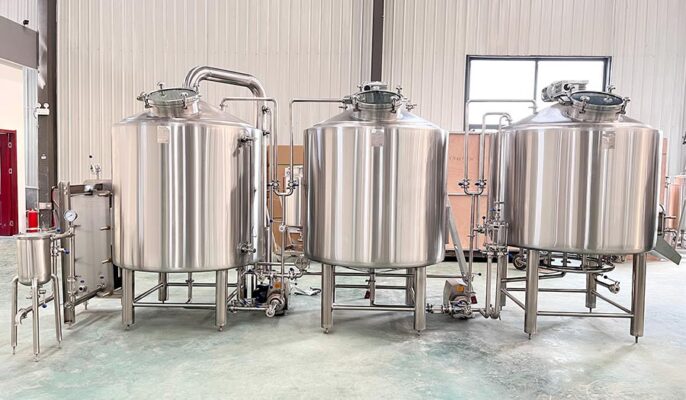
Tipos de equipamento
| Equipamento | Descrição | Opção de nível de entrada | Opção avançada |
|---|---|---|---|
| Chaleira de cerveja | Recipiente fundamental para a trituração dos cereais e a ebulição do mosto. | Tacho de aço inoxidável de 5 galões | Chaleira de aço inoxidável de 10-15 galões com termómetro |
| Tina de brassagem | Recipiente isolado para a trituração de cereais, geralmente com fundo falso ou filtro para separar o mosto. | Arrefecedor de plástico de 5-10 galões com coletor de cobre/trança inoxidável | Tambores de mistura em aço inoxidável personalizados com controlos de temperatura |
| Fermentador | Balde de plástico de qualidade alimentar ou garrafão de vidro/aço inoxidável para fermentar cerveja. | Fermentador de balde de plástico de 6,5 galões com tampa e câmara de ar | Fermentador cónico de aço inoxidável de 7 galões com controlo de temperatura |
| Acessórios | Equipamento para movimentar líquidos, regular a temperatura, efetuar medições. | Mangueiras de nylon, refrigerador de mosto de cobre, pás de plástico, hidrómetro | Bombas de transferência em aço inoxidável, refrigerador de placas, colher de aço inoxidável, refratómetro |
Visão geral do processo de fabricação de cerveja
O processo básico de fabrico de cerveja caseira com equipamento de fabrico de cerveja em grão é:
- Esmagamento - A tina de mosto é enchida com grãos esmagados e água quente para a conversão enzimática de amidos em açúcares fermentáveis. A mistura é mantida a 148-158°F durante 60-90 minutos.
- Lautering - O mosto doce é drenado dos grãos na tina de brassagem através do fundo falso ou do filtro, deixando para trás as cascas dos grãos. A água é enxaguada sobre os grãos para extrair mais açúcares.
- Ebulição - O mosto é fervido na caldeira de fermentação durante 60-90 minutos, sendo o lúpulo adicionado em intervalos para conferir amargor, sabor e aroma. As proteínas e os compostos são coagulados.
- Arrefecimento - O mosto quente é rapidamente arrefecido após a fervura a 60-70°F para evitar sabores estranhos antes de ser transferido para o fermentador.
- Fermentação - A levedura é introduzida no mosto arrefecido no fermentador. Durante mais de 2 semanas, a levedura fermenta os açúcares em álcool e CO2, condicionando a cerveja.
- Embalagem - A cerveja fermentada é carbonatada, engarrafada ou barrilada para ser servida.
Capacidade, dimensões e personalização do equipamento
| Equipamento | Gama de capacidades | Dimensões típicas | Opções de personalização |
|---|---|---|---|
| Chaleiras de cerveja | Lotes de 5-30 galões | 16-24 polegadas de diâmetro, 16-32 polegadas de altura | Escolha do material (inoxidável, alumínio, cerâmica), termómetros, visores, válvulas de esfera, bombas, controladores |
| Tinas de brassagem | Lotes de 5-20 galões | Arrefecedores: 48-108 quartos Cilindros: 12-30 polegadas de diâmetro, 12-36 polegadas de altura | Conceção do fundo falso, tipo de filtro, espessura do isolamento, termómetros, visores, válvulas de esfera, controladores |
| Fermentadores | Lotes de 3-15 galões | Baldes: 12-20 polegadas de diâmetro, 15-35 polegadas de altura Garrafões: 6-14 polegadas de diâmetro, 15-30 polegadas de altura | Escolha do material (plástico, vidro, aço inoxidável), cónico vs. cilíndrico, controlos de temperatura, capacidade de pressão |
Equipamento para fabricação de grãos Fornecedores e gamas de preços
| Equipamento | Fornecedor de nível de entrada e preço | Fornecedor e preço topo de gama |
|---|---|---|
| Kits de chaleiras de cerveja | Cervejeira do Norte - $100 a $250 | Blichmann Engineering - $500 a $1.200 |
| Kits de tina de mosturação | Cervejeira do Norte - $100 a $200 | Tanques robustos - $800 a $2,000 |
| Fermentadores | Aventuras no fabrico de cerveja caseira - $30 a $200 | Ss Brewtech - $300 a $800 |
| Refrigeradores de mosto de imersão | Cervejeira do Norte - $70 a $150 | Jaded Brewing – $200 to $500 |
| Plate Chillers | Adventures in Homebrewing – $90 to $250 | Blichmann Engineering – $300 to $700 |
Instalação, operação e manutenção
| Tarefa | Instructions | Frequência |
|---|---|---|
| Configurar | Review equipment instructions for capacities, temperatures, pressures etc. Connect hoses, cables, controllers per diagrams. | One time |
| Limpeza | Use appropriate cleaners for equipment material (e.g. PBW). Scrub then rinse with hot water or chemical sanitizers. | Every batch pre- and post-brew |
| Substituição | Monitor for leaks, blockages, performance issues. Replace worn parts like o-rings, ball valves, braids etc. | Every 5-10 batches or per manufacturer |
| Calibração | Ensure accurate readings on temperature controllers and density meters via calibration. | Once per year |
How to Choose Grain Brewing Equipment
| Critérios | Orientações para a avaliação |
|---|---|
| Tamanho do lote | Match equipment capacities to typical batch volumes – account for double batches. Standard is 5-10 gallons. |
| Orçamento | All grain equipment has wide cost range. Set budget then identify best value equipment components. |
| Potência | Ensure adequate electrical for heating elements and temperature controllers. Plan 220V for 4500W+ elements. |
| Materiais | Stainless steel preferred for durability but aluminum or glass also common for cost savings. Ensure food-safe. |
| Quality Components | Seek reputable supplier brands for kettles, tuns, chillers etc. Select thick stainless steel with tri-clad bottom. |
| Facilidade de utilização | Pick equipment like pumps and chillers that reduce heavy lifting. Prioritize easy cleanability and maintenance. |
| Limpeza e saneamento | Review product ease of cleaning and compatibility with various cleaners and sanitizers like Star San and PBW. |
| Dimensões | Measure space in brewery to ensure all equipment can fit together properly with room for movement. |
| Flexibilidade | Pick tun sizes to accommodate different batch sizes and brewing styles like lagers and high gravity beers. |
Comparing Pros and Cons of Equipamento para fabricação de grãos
Entry Level Brew Kettle Kits
| Prós | Contras |
|---|---|
| Lower cost stainless models available | Thinner metals may dent |
| Typically include ball valves for transfers | Smaller sizes limit batch lengths |
| Offer kits tailored to home brewing | Maximum temperatures may be capped |
| Provide all fundamental brewing capability | May eventually want to upgrade higher quality kettle |
Fermentadores cónicos
| Prós | Contras |
|---|---|
| Compact size uses less space | Much more expensive than plastic buckets |
| Easy transfer of beers with bottom ports | Heating and cooling requires temperature controllers |
| Allows closed transfers limiting oxygen exposure | Conicals difficult to properly clean without special tools |
| Stainless models match pro breweries | Typically only larger volumes 6 gallons+ |
Additional Comparisons
Plastic Bucket vs. Glass Carboy Fermenters
- Plastic is lighter, cheaper, and less fragile but scratches easily and is more oxygen permeable.
- Glass allows you to visually monitor fermentation, but is heavy, breakable, and costs more.
Immersion vs Plate Wort Chillers
- Immersion chillers are simple to use and cheaper, but slower to chill wort and hard to fully sanitize.
- Plate chillers provide fast chilling and better sanitation but have lower hot side aeration risk and higher equipment cost.
Equipamento adicional de fabrico de cerveja
While a basic all-grain brewing setup requires a mash tun, kettle, and fermenter, there is other equipment that can improve efficiency, convenience and end product quality:
Bombas
- Help move liquid between vessels without lifting and pouring
- Reduce heavy lifting of hot/full kettles and carboys
- Impellers must be cleaned and sanitized to avoid contamination
- March or Chugger pumps popular among homebrewers
Queimadores
- Provide high heat output to boil wort and maintain mash temperatures
- Propane burners offer portability and low cost
- Electric heating elements allow more automation
- High wattage (3500W+) required for 5+ gallon batches
Grain Mills
- Freshly crushed grains have better efficiency and flavor
- Consistent crush essential for good lautering and clear wort
- Corona and Barley Crusher popular quality grain mill brands
- Must be properly adjusted and cleaned to avoid stuck sparges
Limpeza e saneamento
- PBW and Star San leading cleaning/sanitizing products
- Rotation of cleaners prevents build up and resistance
- Clean during brewing to prevent baked-on residue
- Carefully sanitize fermenters, chillers, pumps to prevent infections
- Store grains properly to avoid molds and oxidation
Controlo da temperatura de fermentação
- Precise temp control during fermentation reduces off-flavors
- Cooler temps promote clean lager characteristics
- Consistent ale temps maximize intended ester development
- Glycol chillers, heat belts, or fermentation chambers used
Gestão de leveduras
- Pitching enough healthy yeast is critical for quality beer
- Starters propagate cell counts for proper fermentation
- Stir plates and erlenmeyer flasks effectively grow starters
- Store yeast properly before use for viability and vitality
Draft Systems
- Complete draft/kegging systems available from homebrew suppliers
- Force carbonate finished beers for serving on tap
- Includes CO2 tank, regulators, kegs, shanks, faucets
- Provides convenience of pub style pours at home
Automatização avançada
- Hybrid systems integrate electric heating and pumping
- Programmable controllers manage mashing and fermentation
- Recirculation during mashing increases efficiency
- Requires electrical infrastructure and control knowledge
FAQ
What are the most essential pieces of equipment for all grain brewing?
The absolute necessities are a mash tun for soaking grains, a boil kettle for boiling wort, a fermenter for fermentation, and accessories like an immersion chiller for cooling boiled wort. These pieces allow executing the fundamental brewing process.
What size brew kettle is best for 5 gallon all grain batches?
For a standard 5 gallon batch with potential for a 90 minute boil, an 8-10 gallon brew kettle is optimal. This allows adequate headspace to prevent boilovers. Experienced brewers may use 7.5-8 gallon kettles.
How many fermenters are recommended when starting all grain brewing?
When first getting into all grain brewing, beginning with two 6-7 gallon primary fermenters is recommended. This allows brewing consecutive batches and experimenting with different yeasts. Optionally add a secondary vessel for aging beers.
Is temperature control absolutely necessary for all grain homebrewing?
While many homebrewers start without temp control, managing fermentation temperatures is highly recommended for making clean consistent beer. Simple DIY insulation wraps help minimize swings. Getting a chamber or glycol system is ideal.
What efficiency differences exist between a plastic cooler mash tun and stainless steel tun?
Cooler mash tuns can achieve 60-75% brewhouse efficiency, with proper gap setting on the false bottom. All stainless steel mash tuns with insulation and tight precision parts can reach 75-85% efficiency regularly in the hands of an experienced brewer.
How many years does quality all grain equipment last?
Quality stainless steel brew kettles, conical fermenters, and mash tuns that are properly maintained can last more than 10 years for an avid homebrewer. Items with gaskets, o-rings and moving parts may need minor replacement parts after extended heavy use.

